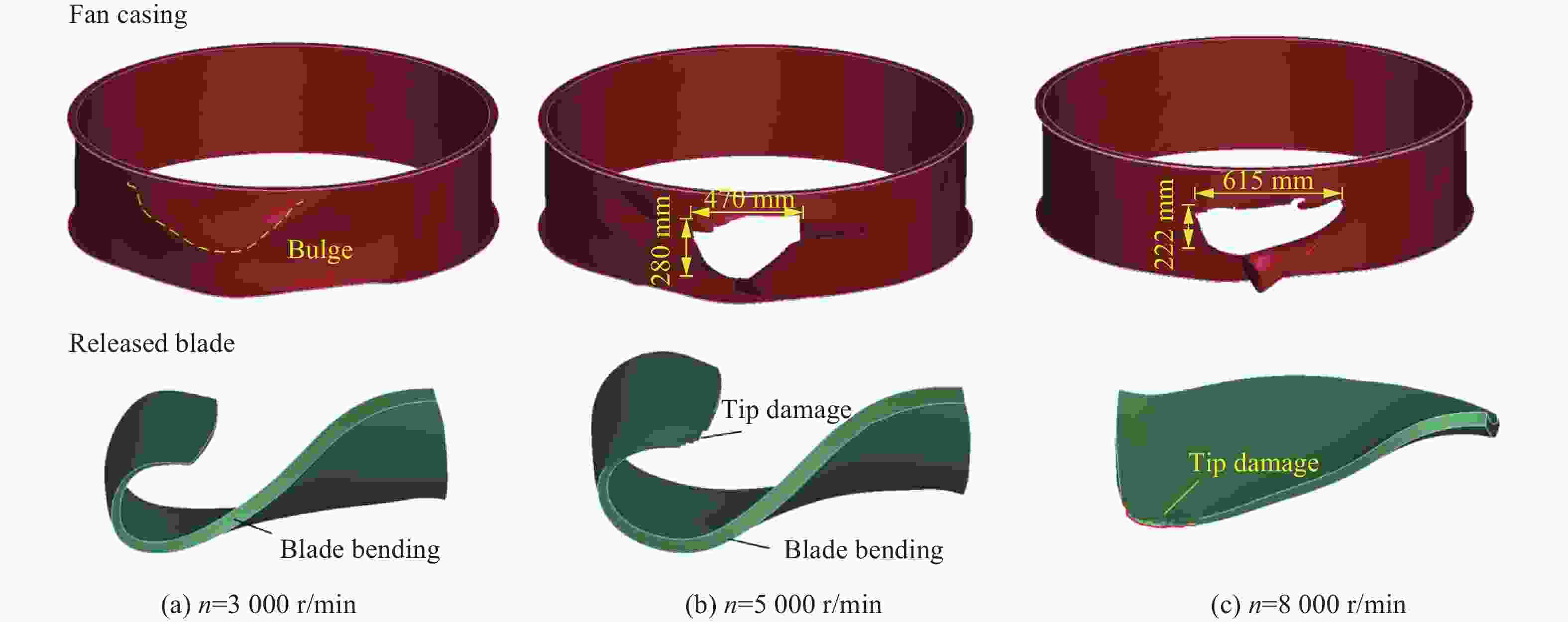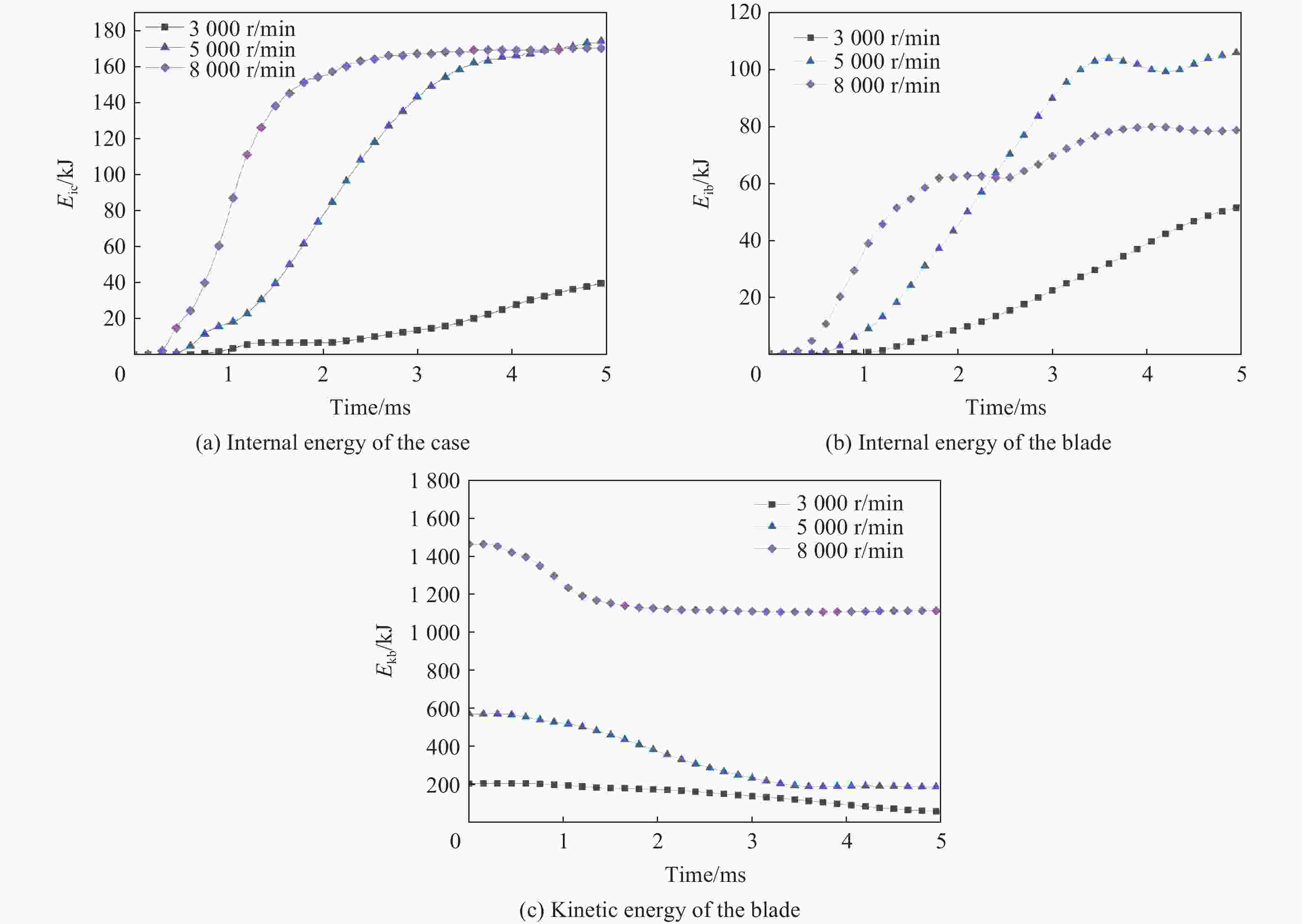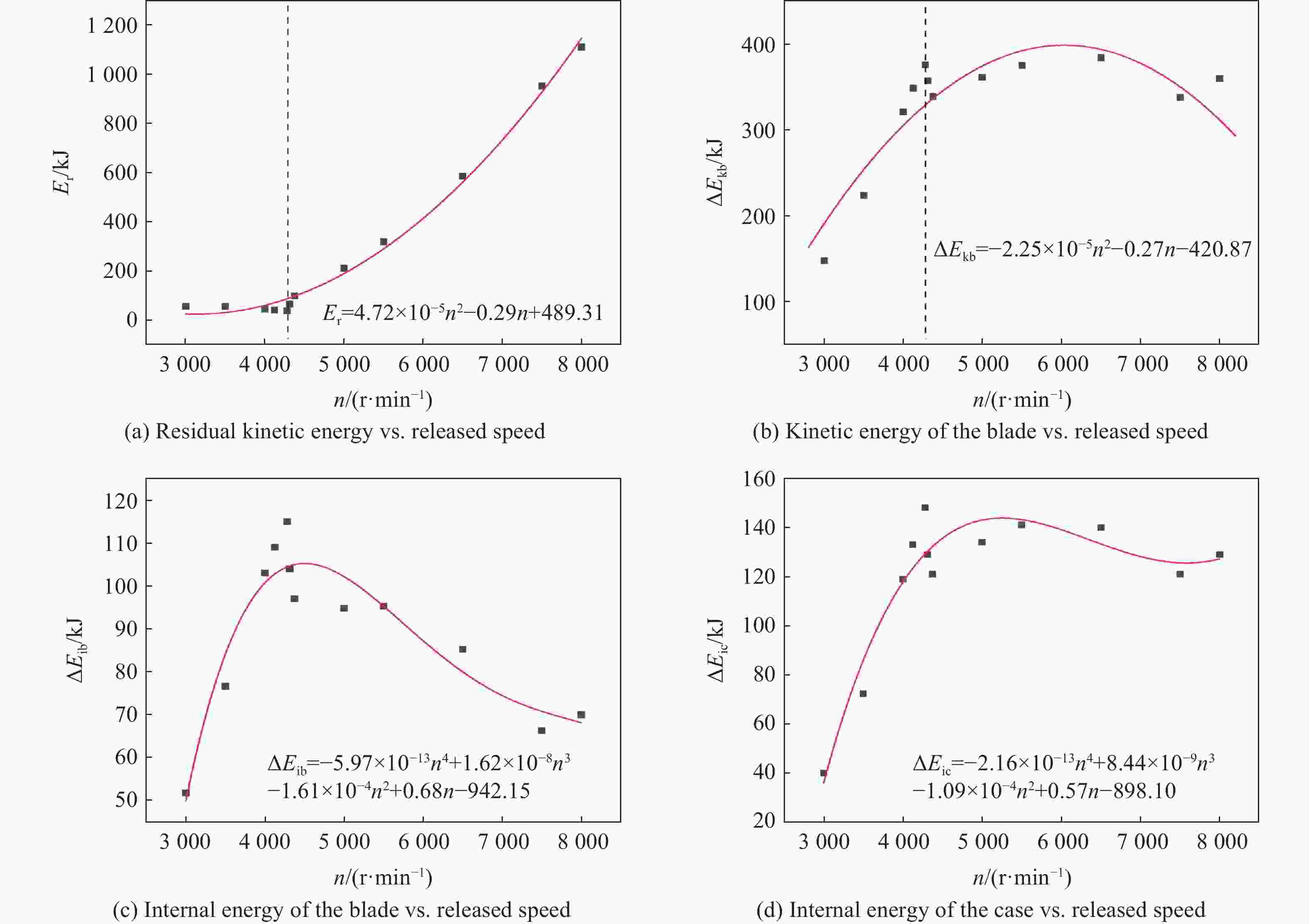Study on the numerical simulation of aeroengine titanium alloy casing containment
-
摘要: 针对发动机风扇机匣包容性评估需求,提出一种结合了打靶试验和有限元分析评估机匣包容能力的方法。采用叶片形弹体冲击半环模拟机匣以获取钛合金机匣的冲击损伤基本特性,并基于接触-碰撞显式动力学分析软件建立相应的数值仿真模型,对比弹体剩余速度、靶板径向变形量以及结构损伤形貌的数值模拟结果与测试结果,二者良好的一致性表明本文数值仿真方法的准确性。然后,采用验证过的数值仿真方法建立真实断裂叶片撞击风扇机匣的计算模型,研究断叶转速及断叶尺寸对机匣包容性的影响。结果表明,旋转状态下风扇机匣的包容能力大于打靶试验中机匣所能承受的叶片冲击能量,工程设计中打靶试验可按照真实机匣临界包容速度的0.76倍进行穿透阈值设计。建立了机匣包容能力表征参量与断叶转速、尺寸的关联模型,发现机匣塑性变形能与叶片丢失转速呈四次方关系,与断叶尺寸呈平方关系;且随着断叶尺寸的增大,机匣临界包容转速呈指数形式下降。Abstract: The containment process of aero-engine casing is very complex, which involves large deformation, material viscoplasticity and nonlinear dynamic response of structural elements. To meet the fan casing containment assessment requirements of engine, a new method combining ballistic impact test and finite element analysis is proposed to evaluate the casing containment capability. A blade-liked projectile was used to impact the half ring simulator to obtain the impact resistance of the titanium alloy casing. The high-speed cameras were positioned perpendicular to the projectile's trajectory to accurately capture and measure its velocities both before and after impact.. The DIC (digital image correlation) technology is used to determine the deformation field of the half ring simulator. Based on the contact-impact dynamics software, a corresponding numerical simulation model was established. The residual velocity of the projectile, radial deformation of the target, and the morphology of structural damage of numerical predictions are compared with those of experimental results. The good agreement between the two results indicated the accuracy of the numerical method. Under the low energy impact, the projectile was rebound, and the half ring absorbed energy with bulge. Whereas in the high energy impact, the projectile penetrated the half ring target and result in tear in the rear surface. Finally, the validated numerical simulation method was employed to simulate the real fan blade/casing containment process, and the effect of the blade rotate speed and the blade size on casing containment are studied. The results show that the fan casing in rotating state can contain more impact energy than that in ballistic impact test. It is suggested that the design for the ballistic impact test can be scaled to 0.76 times the size of the real containment system. Additionally, a parametric correlation model is developed between the casing containment capacity and the characteristics of the released blade, especially the rotate speed and size. It is found that the internal energy of the casing is in a quartic relationship with the blade released speed and a quadratic relationship with the blade size. Moreover, as the blade size increases, the critical containment speed of the casing decreases exponentially.
-
ρ/(g·cm−3) E/GPa cp/(J·kg−1·K−1) ν ρ/(g·cm−3) a γ0 4.428 112.4 580 0.33 5130 0 1.23 A/MPa B/MPa n C mT Tm/K Tr/K $ {\dot{\varepsilon }}_{0} $/s−1 1130 250 0.2 0.032 1 1920 293 1 D1 D2 D3 D4 D5 S1 S2 S3 −0.09 0.27 0.48 0.014 3.87 1.028 0 0 注:cp为定压比热,ν为泊松比,ρ为密度。 表 2 TC4半环模拟机匣试验与仿真结果对比
Table 2. Comparison of test and simulation results of TC4 half ring simulator
工况 靶板厚度/mm 弹体质量/g vi/(m·s−1) 结果 vr/(m·s−1) h/mm 误差/% 试验 仿真 试验 仿真 vr h 1# 7.00 329 120 反弹 − − 9.12 8.87 − 2.74 2# 6.95 327 185 反弹 − − 9.46 9.90 − 4.65 3# 7.03 332 203 穿透 53.0 50.6 − − 4.52 − 表 3 不同断叶尺寸下的数值仿真结果
Table 3. Simulation results of different blade size
断叶质量/kg 结果 初始动能/kJ 剩余动能/kJ 机匣应变能/kJ 相互作用力/kN 第1次 第2次 2.655 包容 227 61.9 69.6 49.8 8.86 4.940 穿透 358 77.3 126 48.2 16.3 7.574 穿透 464 126 143 53.2 31.3 10.316 穿透 538 183 140 68.4 52.5 12.597 穿透 573 193 134 72.49 77.77 -
[1] 陈光. 航空发动机结构设计分析 [M]. 3版. 北京: 北京航空航天大学, 2023: 542–546. [2] 宣海军, 陆晓, 洪伟荣, 等. 航空发动机机匣包容性研究综述 [J]. 航空动力学报, 2010, 25(8): 1860–1870. DOI: 10.13224/j.cnki.jasp.2010.08.012.XUAN H J, LU X, HONG W R, et al. Review of aero-engine case containment research [J]. Journal of Aerospace Power, 2010, 25(8): 1860–1870. DOI: 10.13224/j.cnki.jasp.2010.08.012. [3] 谭毅, 杨书仪, 左建华, 等. 面向包容性的航空发动机机匣研究综述 [J]. 航空工程进展, 2022, 13(6): 17–28. DOI: 10.16615/j.cnki.1674-8190.2022.06.02.TAN Y, YANG S Y, ZUO J H, et al. Review of aero-engine casing containment research [J]. Advances in Aeronautical Science and Engineering, 2022, 13(6): 17–28. DOI: 10.16615/j.cnki.1674-8190.2022.06.02. [4] 洪杰, 马艳红. 航空燃气涡轮发动机结构与设计 [M]. 北京: 科学出版社, 2021: 76–81.HONG J, MA Y H. Structure and design of aircraft gas turbine engine [M]. Beijing: Science Press, 2021: 76–81. [5] 中国民用航空总局. 航空发动机适航规定:CCAR-33 [S]. 北京: 中国民用航空总局, 2005: 78–79. [6] Unite State Air Force. Engine structural integrity program: MIL-STD-1783B [S]. United States: Department of Defense, 2002: 9–10. [7] US Department Transportation Federal Aviation Administration. Airworthiness standards: aircraft engines: FAR33 [S]. United States: Federal Aviation Administration: 1984: 81–99. [8] HE Z K, GUO X J, XUAN H J, et al. Characteristics and mechanisms of turboshaft engine axial compressor casing containment [J]. Chinese Journal of Aeronautics, 2021, 34(1): 171–180. DOI: 10.1016/j.cja.2020.08.050. [9] XUAN H J, WU R R. Aeroengine turbine blade containment tests using high-speed rotor spin testing facility [J]. Aerospace Science and Technology, 2006, 10(6): 501–508. DOI: 10.1016/j.ast.2006.04.006. [10] HE Q, XUAN H J, LIU L L, et al. Perforation of aero-engine fan casing by a single rotating blade [J]. Aerospace Science and Technology, 2013, 25(1): 234–241. DOI: 10.1016/j.ast.2012.01.010. [11] YU M Y, WANG J F, XUAN H J, et al. Simulation and experimental study of gas turbine blade tenon-root detachment on spin test [J]. Aerospace, 2024, 11(8): 629. DOI: 10.3390/aerospace11080629. [12] 徐雪, 李宏新, 冯国全. 风扇叶片飞失显式动力学仿真网格与时间步长研究 [J]. 航空发动机, 2021, 47(5): 12–18. DOI: 10.13477/j.cnki.aeroengine.2021.05.003.XU X, LI H X, FENG G Q. Study on mesh and time step of explicit dynamic simulation for fan blade out [J]. Aeroengine, 2021, 47(5): 12–18. DOI: 10.13477/j.cnki.aeroengine.2021.05.003. [13] MEGUID S A. Multiple blade shedding in aviation gas turbine engines: FE modeling and characterization [J]. International Journal of Mechanics and Materials in Design, 2024, 20(4): 663–670. DOI: 10.1007/s10999-023-09696-z. [14] ZHAO Z H, WANG L F, LU K N, et al. Effect of foreign object damage on high-cycle fatigue strength of titanium alloy for aero-engine blade [J]. Engineering Failure Analysis, 2020, 118: 104842. DOI: 10.1016/j.engfailanal.2020.104842. [15] MOHAMMAD Z, GUPTA P K, BAQI A. Experimental and numerical investigations on the behavior of thin metallic plate targets subjected to ballistic impact [J]. International Journal of Impact Engineering, 2020, 146: 103717. DOI: 10.1016/j.ijimpeng.2020.103717. [16] 张铁纯, 王陆军, 胡昂, 等. 弹体撞击角度对TC4薄板抗半球形弹冲击性能影响 [J]. 机械强度, 2021, 43(3): 546–553. DOI: 10.16579/j.issn.1001.9669.2021.03.006.ZHANG T C, WANG L J, HU A, et al. The effect of impact angle on the ballistic performance of TC4 target against the impact of hemi-spherical projectile [J]. Journal of Mechanical Strength, 2021, 43(3): 546–553. DOI: 10.16579/j.issn.1001.9669.2021.03.006. [17] CARNEY K S, PEREIRA J M, REVILOCK D M, et al. Jet engine fan blade containment using an alternate geometry [J]. International Journal of Impact Engineering, 2009, 36(5): 720–728. DOI: 10.1016/j.ijimpeng.2008.10.002. [18] ZHANG H B, HU D Y, YE X B, et al. A simplified Johnson-Cook model of TC4T for aeroengine foreign object damage prediction [J]. Engineering Fracture Mechanics, 2022, 269: 108523. DOI: 10.1016/j.engfracmech.2022.108523. [19] 周伦, 苏兴亚, 敬霖, 等. 6061-T6铝合金动态拉伸本构关系及失效行为 [J]. 爆炸与冲击, 2022, 42(9): 091407. DOI: 10.11883/bzycj-2022-0154.ZHOU L, SU X Y, JING L, et al. Dynamic tensile constitutive relationship and failure behavior of 6061-T6 aluminum alloy [J]. Explosion and Shock Waves, 2022, 42(9): 091407. DOI: 10.11883/bzycj-2022-0154. [20] JOHNSON G R, COOK W H. A constitutive model and data for materials subjected to large strains, high strain rates, and high temperatures [C]//Proceedings of the 7th International Symposium of Ballistics. The Hague, The Netherlands: American Defense Preparedness Association, 1983: 541-547. [21] JOHNSON G R, COOK W H. Fracture characteristics of three metals subjected to various strains, strain rates, temperatures and pressures [J]. Engineering Fracture Mechanics, 1985, 21(1): 31–48. DOI: 10.1016/0013-7944(85)90052-9. [22] HALLQUIST J O. LS-DYNA keyword user's manual (version 970) [M]. Livermore, CA, USA: Livermore Software Technology Corporation, 2003: 299-800. [23] 惠旭龙, 牟让科, 白春玉, 等. TC4钛合金动态力学性能及本构模型研究 [J]. 振动与冲击, 2016, 35(22): 161–168. DOI: 10.13465/j.cnki.jvs.2016.22.024.HUI X L, MU R K, BAI C Y, et al. Dynamic mechanical property and constitutive model for TC4 titanium alloy [J]. Journal of Vibration and Shock, 2016, 35(22): 161–168. DOI: 10.13465/j.cnki.jvs.2016.22.024. [24] LIU J, ZHENG B L, ZHANG K, et al. Ballistic performance and energy absorption characteristics of thin nickel-based alloy plates at elevated temperatures [J]. International Journal of Impact Engineering, 2019, 126: 160–171. DOI: 10.1016/j.ijimpeng.2018.12.012. -







 下载:
下载:












